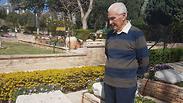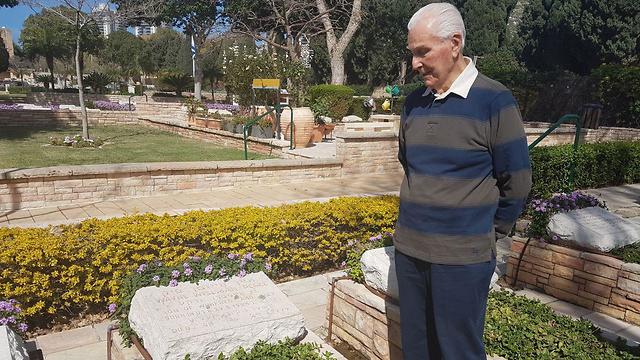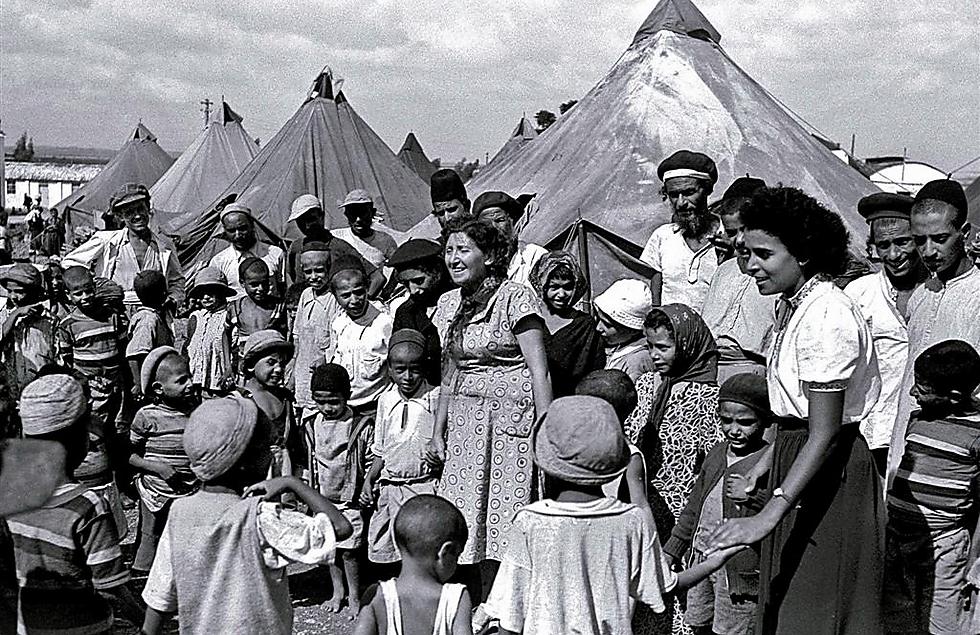

Operation On Wings of Eagles remembered by volunteer pilot
As a young navigator with Alaska Airlines, Elgen Long volunteered to airlift 1,800 endangered Jews from Yemen to Israel in 1949, taking part in 12 separate airlifts; now, at 91, he came to visit the descendants of those he saved in Israel for the first time and reminisced about the clandestine mission; 'We flew nonstop, and did not file any flight plan, it was all secret,' he recounted.
Understandably, the graves of soldiers who fell in the 1948 War of Independence at the Haifa Military Cemetery do not receive many visitors. Their parents are no longer alive and the second and third generations rarely visit the graves of their grandfathers or uncles. But the Mahal (foreign volunteers to the IDF) graves receive even less visitors.
On Friday, the cemetery received a special visitor: Elgen Long, 91, from Reno, Nevada, was a young navigator with Alaska Airlines when he found himself in the midst of Operation On Wings of Eagles as a volunteer who lent a hand to the nascent Israeli Air Force in airlifting the Yemenite Jewish community to the newly founded Jewish state.
Long asked to be taken to the grave of his friend, captain and fellow Mahal volunteer Wayne Pick, who was buried alongside his friends at the Haifa military cemetery.
He recounted, “I was a navigator with Alaska Airlines and Captain Curry was the captain of a DC-4,” said Long. “We were in Tel Aviv and we had just brought a load of refugees from China, they were all stateless we found a way to get them to Israel. And when we got there, we got to the hotel and didn’t know what to do next.

“The company sent us a cable and it said: ‘Go to Aden and the commander there will meet you there.’ We landed and he told us of the plight of the Yemenite Jews who had found their way to Aden after crossing the desert, on foot. They were in dire straits, no facilities for them, it was hard to protect them. They were dying of diseases and they had to get to Israel and get out of there as soon as possible.”
He continued: “They asked us how many we could carry, so we figured they only weighed about 80 pounds each. They had no luggage and we could carry about 150 (of them) with enough fuel to get to Tel Aviv, then known as Lydda. We carried about 2,000 of them; we were the only airplane and crew there. Because it was a matter of life and death, we flew on the Sabbath, we did not stop, back and forth.
“Twelve flights, 1,800 people, that was before Operation Magic Carpet (had officially begun), a few months earlier… Actually Magic Carpet was with benches and seats, they could carry about 107 passengers and rarely did they fit in 120. But that continued for over a year after we left. I was one of a crew of about six men. I just did my job as a navigator; we could not land in an Arab country because of the war, which was just ending. We did not file any flight plan, it was all secret, nothing was in the papers or the radio. We just flew up the middle of the Red Sea and up the Gulf of Aqaba until Um Rushrush (now Eilat), then turned towards Be’er Sheva, then to Lydda. Stand With Us brought us to Israel and sponsored and arranged for me to come here today,” Long explained.
This week, almost 70 years after that operation, Long returned to Israel on a trip organized by “Stand With Us” and the Association for the Preservation of Yemenite Jewish Heritage. “During my tenure as consul, I discovered that there is a Jewish museum in Anchorage, Alaska,” said Shahar Azani from “Stand With Us.”
“When I visited, I discovered this story and Elgen’s story. I got to know him and we made a ceremony in his honor. When I offered him a visit to Israel he asked for two things: to meet with the descendents of the Jews he helped airlift from Yemen and to visit the gravesite of Wayne Pick in Haifa.” It turns out, that Azani’s own father and grandfather were participants of the airlift.
During his visit, Long could not contain his excitement and shed a tear. “He practically taught me how to fly,” he said, standing by Pick’s grave. “He was a brave pilot who flew Tiger Line planes and I had just begun learning how to fly transport aircraft. He taught me how to fly, I was lacking experience and he was kind and considerate enough to take the time to help me do it right. He taught me well, he did a great job. He was a great instructor and then we became friends and had some beers together,” Long reminisced.
Long brought along some small stones from his home in Nevada, which he placed on the grave. “Maybe we will fly together again, soon,” he promised.
“This visit carries a lot of symbolism and conveys a double message,” said Dr. Yigal Ben Shalom, Director of the Association for Preservation of Yemenite Jewish Heritage. “Long was one of those good men who, during the early years of the state, took a huge risk for our sake and we appreciate their contribution, because we—the many Yemenite Jews who came to Israel, and their descendants—owe him a debt of gratitude for the success of the clandestine immigration to Israel.”
He added: “His meeting with those Yemenite immigrants and their descendants, as well as other Yemenite immigrants, points to something no less astonishing about the Zionist enterprise. With all the difficulties of a different culture and the difficulties of integration, Yemenite Jews succeeded here amazingly.
“Long was so excited to meet happy, satisfied people who live here and raised families and succeeded in their careers in all walks of life. The second message is the need to preserve the memory and emphasize the heritage so that it will be known to all of Israel."

















